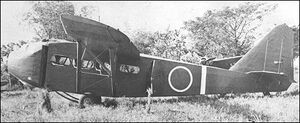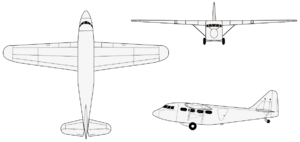Engineering:Kokusai Ku-8
| Ku-8 | |
|---|---|

| |
| Ku-8-II | |
| Role | Transport glider |
| National origin | Japan |
| Manufacturer | Nippon Kokusai Koku Kogyo K.K |
| First flight | May 22, 1943 |
| Primary user | Imperial Japanese Army Air Service |
| Number built | ~700 |
| Developed from | Kokusai Ki-59 |
The Kokusai Ku-8-II (国際 ク8 四式特殊輸送機 Kokusai ku 8 yonshiki tokushū yusōki) (Kokusai Army Type 4 Special Transport Glider[1]) was a Japanese military glider used during the Second World War.
Design and development
Design of the Ku-8-II began in December 1941, the glider was essentially a Kokusai Ki-59, with the engines and fuel tanks removed and a modified undercarriage. It was given the Allied code name Goose and later Gander. The prototype was completed on May 20, 1943, and took to the air two days later, on May 22, 1943.[2]
A Ku-8-II version that was produced in 1944 used a tubular steel frame structure, and had a hinged nose that could be opened to the side to allow loading. Also, its capacity was increased slightly to carry twenty troops.[3] In total, approximately 700 were built. They were used operationally in the Philippines , primarily to carry supplies.
Variants
- Ku-8-I:Prototypes.
- Ku-8-II:Military transport glider. Production version.
Operators
 Japan
Japan
- Imperial Japanese Army
Specifications
Data from topsid.com:Kokusai Ku-8-II,[4] Japanese Aircraft of the Pacific War,[5] Fighting gliders of World War II[6]
General characteristics
- Crew: 2
- Capacity: 20 troops, equipped; mountain howitzer with crew / 1,790 kg (3,950 lb) payload
- Length: 13.31 m (43 ft 8 in)
- Wingspan: 23.2 m (76 ft 1 in)
- Height: 2.96 m (9 ft 9 in)
- Wing area: 50.5 m2 (544 sq ft)
- Empty weight: 1,630 kg (3,594 lb)
- Gross weight: 3,500 kg (7,716 lb)
Performance
- Never exceed speed: 240 km/h (150 mph, 130 kn)
- Maximum glide ratio: 15.9:1
- Maximum towing speed: 224 km/h (139 mph; 121 kn)
See also
Related lists
References
- ↑ "Japanese Aircraft Designations 1939-1945". http://rwebs.net/avhistory/acdesig/japanese.htm.
- ↑ "Kokusai Ku.8" (in ru). http://www.airwar.ru/enc/glider/ku8.html/.
- ↑ *Donaldson, Graham. "The Japanese paratroopers in the Dutch East Indies, 1941-1942". The Netherlands East Indies 1941-1942. https://warfare.gq/dutcheastindies/japan_paratroop.html.
- ↑ "Kokusai Ku-8-II" (in cs). http://www.topsid.com/index.php?war=japonsko&unit=kokusaiku-8-ii.
- ↑ Francillon, Rene (1979). Japanese Aircraft of the Pacific War. London: Putnam & Company Limited. p. 484. ISBN 0-370-30251-6.
- ↑ Mrazek, James E. (1977). Fighting gliders of World War II. London: Hale. pp. 89-95. ISBN 978-0312289270. https://archive.org/details/fightinggliderso00mraz/page/89.
External links
- Budge, Kent G.. "The Pacific War Online Encyclopedia: Ku-8 "Gander", Japanese Glider". http://pwencycl.kgbudge.com/K/u/Ku-8_Gander.htm.
 |


